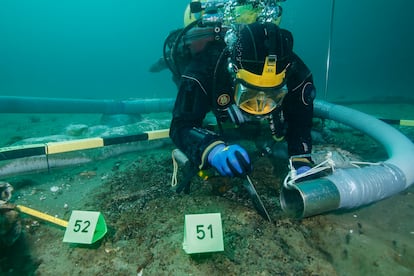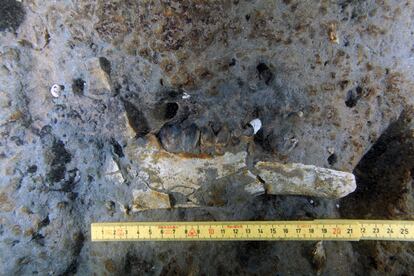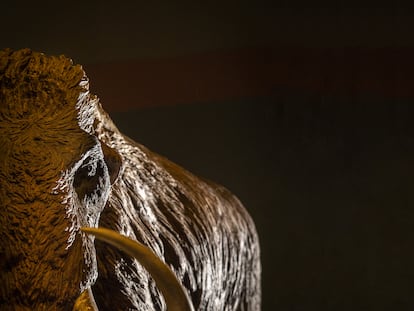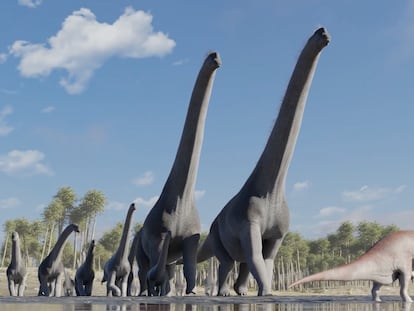Deer, American horses and mylodons populated a wetland that today is a ‘sacrifice zone’
In Quintero Bay, in Chile, 7,000 fossil remains of an abundant extinct megafauna that inhabited the place during the late Pleistocene have been found

In Quintero Bay, on the Pacific coast of Chile, underwater archaeologist Diego Carabias and the team of researchers that make up the group known as Millennium Nucleus Ocean, Heritage and Culture (OHC), have found fossil remains of giant camelids, large deer, American horses and mylodons — a megafauna that lived 24,000 years ago in a large expanse of wetlands that was rich in biodiversity.
Today, that site covered by sea level rise after the Last Glacial Maximum (LGM) is known as “GNL Quintero1 (GNLQ1)” and is a “sacrifice zone,” polluted by the area’s industrial activity. The site was found 2,130 feet from the coast and 42.5 feet deep. The extinct continental fauna was recovered through underwater archaeological excavations whose research provides detailed information on these so-called “flooded paleo-landscapes.”
The identified bone remains were dated between the years 19,280 and 24,890 BC. This submerged paleontological site is the first to be studied collaboratively, with experts from South America, South Africa and Australia.
“Also, as a team, we are working with coastal communities that can contribute their own ancestral knowledge, which will allow us to identify various types of submerged archaeological sites in the future,” said Carabias at the Puerto de Ideas festival held in the city of Concepción at the end of August, where he explained his research in detail.
Getting closer to those who live in the places where he carries out his explorations is part of the work methodology of this underwater archaeologist with more than two decades of experience. “The knowledge of coastal inhabitants in general is the result of a human evolution that concentrates ancestral Indigenous traditions,” says the specialist. “Chile is a mestizo country, where there is a substrate of Indigenous knowledge of adaptation to the maritime environment that is thousands of years old and that is highly underrecognized. We are a mestizo country. And a maritime country. And there is that deep connection with the sea, because we are standing on a coastal edge from top to bottom,” reflects Carabias with the sea breeze on his face. The marine archaeologist has given numerous conferences and has worked with various projects developed in South America, Europe and Oceania. Today he is a permanent member of the Intersectoral Working Group on Underwater Cultural Heritage of Chile, and he has put together three museum exhibitions on underwater heritage in the port of Valparaíso.
“This used to be an exceptional site”
“In the paleontological evidence that is still being studied by the OHC, with funding from ANID (Chile’s National Research and Development Agency), evidence was found that it was an area rich in life, but today that contrasts with excessive industrial development that impacts the natural environment,” Carabias accuses. After modeling the landscape, the expert concluded that “these wetlands were located seven kilometers [4.3 miles] from the coast at that time. This same fauna is also present in other places of the Pacific coast, so they were common species of coastal wetlands. Our research shows that before Puchuncaví-Quintero was a ‘sacrifice zone,’ this used to be an exceptional site.”
Nearly 7,000 bone pieces from eight extinct species were documented with photogrammetry techniques, which allowed the scientists to generate 3D models that helped them interpret the paleontological remains.
Furthermore, these excavations allow us to understand the great alterations that the landscape has undergone over time: “The two large coastal lagoons that dominated the bay no longer exist, and the pollution from industrial activities in the last 150 years is evident. This is seen in the heavy metals that have been found in the analysis of the most recent sediments,” explains the researcher.
The technique used in Quintero was excavation by strata. This means that sediments were vacuumed up in order to recover the submerged megafauna in blocks. The multidisciplinary project included archaeologists, geologists and conservators. After the careful recovery of the bone remains, extensive conservation work was necessary to stabilize the archaeological material before analyzing it. “The field work used technologies such as sonars and sub-bottom profilers. This allowed us to identify dominant sediments and paleoforms,” adds Carabias, who is systematically studying all the evidence that lies submerged in the ocean floor.
“They are considered sources of primary, unprecedented information on how, in the past, human and animal groups have related to the ocean throughout human history. This has enormous potential for the region, both economically and culturally,” concluded the expert during a break in the setup of the exhibition La memoria sumergida (The submerged memory), which he recently curated. The exhibition — with images of submerged archaeological sites taken in the course of 20 years of work — is currently on display at the National Congress of Chile, and its goal is to raise awareness among legislators and the general public about the Convention on the Protection of Underwater Cultural Heritage, promoted by UNESCO and ratified by 73 states, 21 of them from Latin America and the Caribbean. Two decades later, Chile still has not joined the convention.
Carabias found his passion for exploring the ocean floor when he was a teenager and used to spend the summer at his grandmother’s house in Algarrobo, Chile. “I didn’t put on my shoes until I went back to school,” he recalls. He began to study archeology at the University of Chile, where he realized that, by studying the seabed, he could combine two of his passions: diving and exploring the remains of the past. For him, exploring underwater is the same as digging on land: an area is defined in grid units, and in that way one advances, patiently.
The submerged archaeological sites contain previously unknown information. They are a primary source on humanity’s past that can be researched in depth. There, at the bottom of the sea, Carabias studies the underwater landscapes and prehistoric sites, the indigenous vessels and the various shipwrecks that took place in the colonial and republican period. “I became a person of the sea and an eternal learner of the depths. What I am most passionate about is interacting with people from maritime communities. They have an oral tradition, a worldview, a genetic memory and a special way of conceiving life,” he concludes.

Sign up for our weekly newsletter to get more English-language news coverage from EL PAÍS USA Edition
Tu suscripción se está usando en otro dispositivo
¿Quieres añadir otro usuario a tu suscripción?
Si continúas leyendo en este dispositivo, no se podrá leer en el otro.
FlechaTu suscripción se está usando en otro dispositivo y solo puedes acceder a EL PAÍS desde un dispositivo a la vez.
Si quieres compartir tu cuenta, cambia tu suscripción a la modalidad Premium, así podrás añadir otro usuario. Cada uno accederá con su propia cuenta de email, lo que os permitirá personalizar vuestra experiencia en EL PAÍS.
¿Tienes una suscripción de empresa? Accede aquí para contratar más cuentas.
En el caso de no saber quién está usando tu cuenta, te recomendamos cambiar tu contraseña aquí.
Si decides continuar compartiendo tu cuenta, este mensaje se mostrará en tu dispositivo y en el de la otra persona que está usando tu cuenta de forma indefinida, afectando a tu experiencia de lectura. Puedes consultar aquí los términos y condiciones de la suscripción digital.
More information
Archived In
Últimas noticias
The new victims of the Republican war on Obamacare: Millions hit by soaring health insurance premiums
A country divided on migrant rights: Some US states expand protections while others restrict them
Venezuela authorizes the release of another 87 political prisoners
There is as much life left to discover on planet Earth as that which is already known
Most viewed
- David King, chemist: ‘There are scientists studying how to cool the planet; nobody should stop these experiments from happening’
- Reinhard Genzel, Nobel laureate in physics: ‘One-minute videos will never give you the truth’
- Oona Chaplin: ‘I told James Cameron that I was living in a treehouse and starting a permaculture project with a friend’
- Sinaloa Cartel war is taking its toll on Los Chapitos
- The Interoceanic Train, the Mexican alternative to the Panama Canal










































